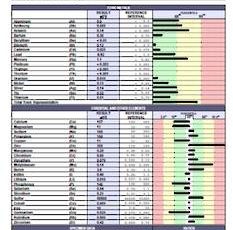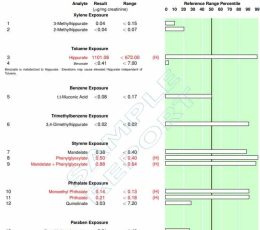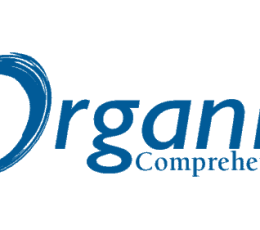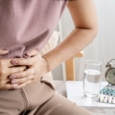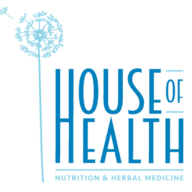
THE REGULATION OF OESTROGEN LEVELS IS A COMPLEX AND FINELY TUNED OPERATION. WHEN BALANCED, MESSAGES ARE COMMUNICATED SEAMLESSLY. BUT WHEN LEVELS FLUCTUATE TOO HIGH OR TOO LOW, UNPLEASANT SYMPTOMS AND ILLNESS MAY OCCUR.
Oestrogen is a group of hormones primarily found in females, although males also have small amounts. These hormones, including oestradiol, oestrone, and oestriol, play a pivotal role in regulating various physiological processes.
Oestrogen is produced mainly in the ovaries in females and in smaller quantities in the testes in males. Its functions encompass regulating the menstrual cycle, promoting the development of secondary sexual characteristics like breast growth and body fat distribution, maintaining bone density, and supporting healthy cardiovascular and reproductive systems.
Oestrogen levels fluctuate throughout a woman’s life from puberty to menopause and can have profound effects on her health and well-being.
Oestrogen is not just one hormone but a group of compounds including oestradiol (the predominant form of oestrogen), oestrone and oestriol. These are often referred to as E1, E2 and E3. In women, oestrogens are produced in high amounts during the reproductive years from cholesterol. This happens in the ovaries, and to a lesser extent in breast tissue, and fat cells. Recent discoveries indicate some types of oestrogen are also produced in the brain, liver and bone cells.
Additionally, oestrogen can be synthesised from androgen hormones (including testosterone and DHEA) within fat cells in a process called aromatisation. This group of hormones not only play an integral role in reproductive health, they also impact other parts of the body including the gut, brain, adipose (fat) tissue, skeletal and cardiovascular systems [1, 2].
The liver is a site for biosynthesis of oestrogens and is also the main site for further biotransformation of them. Oestrone is in equilibrium with oestradiol and 17-b-hydroxysteroid dehydrogenase (17bHSD) in this respect. The oestrogens are taken up by the liver where they are biotransformed further into different metabolites. The major oxidative routes of oestrone and oestradiol are via 2- and 4-hydroxylation by cytochrome P450 (CYP) 2B1, 1A and 3A.
The 2- and 4-hydroxy derivatives (and other metabolites) will be further converted to 2- and 4-methoxy metabolites by and enzymes called catechol-O-methyltransferase (COMT).
While the hydroxylated metabolites appear to result in DNA damage and contribute to the tumerogenic effect of oestrogen, the methoxy-derivatives appear to exhibit beneficial cardiovascular effects. Oestrone and oestradiol and their metabolites undergo sulphation by sulphotransferases (SULTs) and glucuronidation by glucoronyltransferases (UGTs). Oestrone and oestradiol sulphates can be deconjugated by sulphatases (STs).
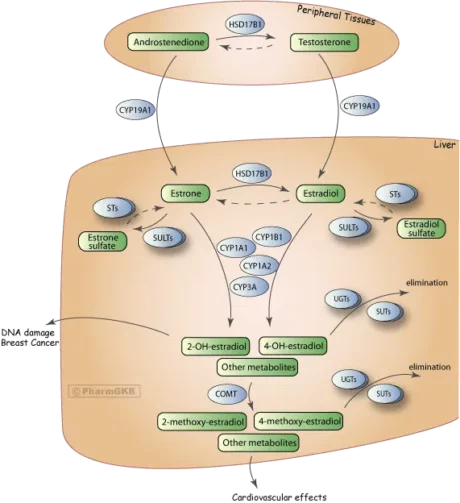
The detoxification of oestrogen for removal from the body occurs within the liver via a two-step pathway. First, Phase 1: hydroxylation (turns a fat based molecule into a water based compound), then Phase 2: conjugation, which involves 3 different pathways; methylation, glucuronidation, and sulphation.
After this, the final packaged product is able to be removed via urine or the stool. However, in a gut with elevated levels of ß-glucuronidase-producing bacteria, large amounts of conjugated oestrogens can be reverted back into their free forms and absorbed back into the bloodstream (this is called enterohepatic recirculation) [1,10].
Oestrogen also has a key role in the regulation of the gut microbiota (the collection of microbes within the whole digestive system).
The number and range of types (diversity) of bacteria within the gut can be altered by oestrogen levels. This is reflected in research demonstrating different microbial profiles between men and women, and changes occuring during pregnancy and after menopause.
Conversely, gut bacteria has an influence on oestrogen levels via a group of gut microbes termed the oestrobolome [5,6].
The oestrobolome is sub-group of bacteria that can metabolise and modulate oestrogen levels within the body. These microbes are hungry for the glucuronic acid molecule attached to oestrogen during the liver’s process of detoxifying it.
Bacteria within the oestrobolome contain an enzyme called ß-glucuronidase that can break the bond formed during conjugation, releasing oestrogen and allowing it to re-enter the bloodstream. Any variation in the oestrobolome will therefore directly impact the level of oestrogens circulating in the blood.
Additionally, these bacteria thrive in an environment that is fuelled with a high-fat and low-fibre diet [7,8,9].
Elevated levels of oestrogen can contribute to and fuel conditions including premenstrual syndrome (PMS), premenstrual dysphoric disorder (PMDD), endometriosis and hormone-driven cancers including endometrial, ovarian and breast cancer. In contrast, a low oestrogen state is linked to obesity, metabolic syndrome, polycystic ovary syndrome (PCOS), cardiovascular disease, osteoporosis and cognitive decline. Fluctuations in oestrogen levels are also linked to symptom flare-ups in women with irritable bowel syndrome (IBS).
Research reveals that oestrogen has a critical role in pain perception and sensitivity, muscle movements of the gut (motility), mast cell activation, the stress response and inflammation [1,2,3,4]. Thus, the homeostatic balance of oestrogen is vital for health, as well as prevention of certain diseases.
Absolutely! Here are some tips for incorporating into your daily routine:
Enhance healthy metabolism of oestrogen by increasing your cruciferous vegetable intake (such as broccoli, broccoli sprouts, bok choy, cauliflower, cabbage and brussel sprouts). These vegetables contain liver-loving nutrients including sulforaphane, and indole-3-carbinol, from which diindolylmethane (DIM) is made.
Also ensure plenty of B vitamins in your daily diet, specifically folate, vitamins B2, B6, and B12. Vital for methylation pathways and oestrogen conjugation, these vitamins can be found in a variety of foods including whole grains, nuts, milk, beef, poultry and dark leafy greens.
Other researched nutrients include turmeric (for its curcumin), rosemary, magnesium, calcium D-glucarate and D-limonene (found in the oils in the skin of citrus fruits), polyphenols in berries and foods containing resveratrol (such as grapes, peanuts and soy). These nutrients all promote healthy Phase I and II processes in the liver [10,11,12,].
Dietary fibre and whole grains have been shown to improve bacterial diversity and overall function. Fibres also support health-promoting bacteria.
Lignin fibre (found in flaxseeds, grains and seeds) also binds to unbound oestrogen in the gut, thus facilitating its excretion in stools. Lignans have also been shown to reduce aromatisation processes, which reduces the conversion of androgens to oestrogen [10,14].
Alcohol consumption is linked to increased oestrogen levels via increased aromatisation of androgens. Regular alcohol consumption also inhibits healthy liver function [10,15].
Environmental toxins (often referred to as endocrine disrupting chemicals – EDCs) are found in pesticides, plastics, personal hygiene products and industrial solvents. Those that are foreign to humans but have a similar structure to oestrogen may bind to oestrogen receptors. These are called xenooestrogens.
Ideally, minimise exposure to EDCs by limiting the use of plastics, such as in water bottles, plastic cooking utensils, plastic-lined tins and plastic wrap.
Bisphenols are particularly nasty and are linked to hormone-driven cancers. This group includes bisphenol-A (BPA), bisphenol-B, bisphenol-C, bisphenol-F and bisphenol-S. These compounds are found in plastic products and the thermal paper widely used for check-out receipts. [10,16,17]. You can check your body burden of several of these problematic compounds with an Environmental Pollutants urine test.
Find out about your gut microbes and if they could be affecting oestrogen levels. This can be achieved with a comprehensive microbiome stool test.
Additionally, an assessment of your hormones with a DUTCH test (Dried Urine Test for Comprehensive Hormones) can provide information about levels of various hormones and their metabolism pathways.
One of our practitioners can assess liver function and guide you with nutritional, supplemental and lifestyle treatments to re-establish hormone harmony.

